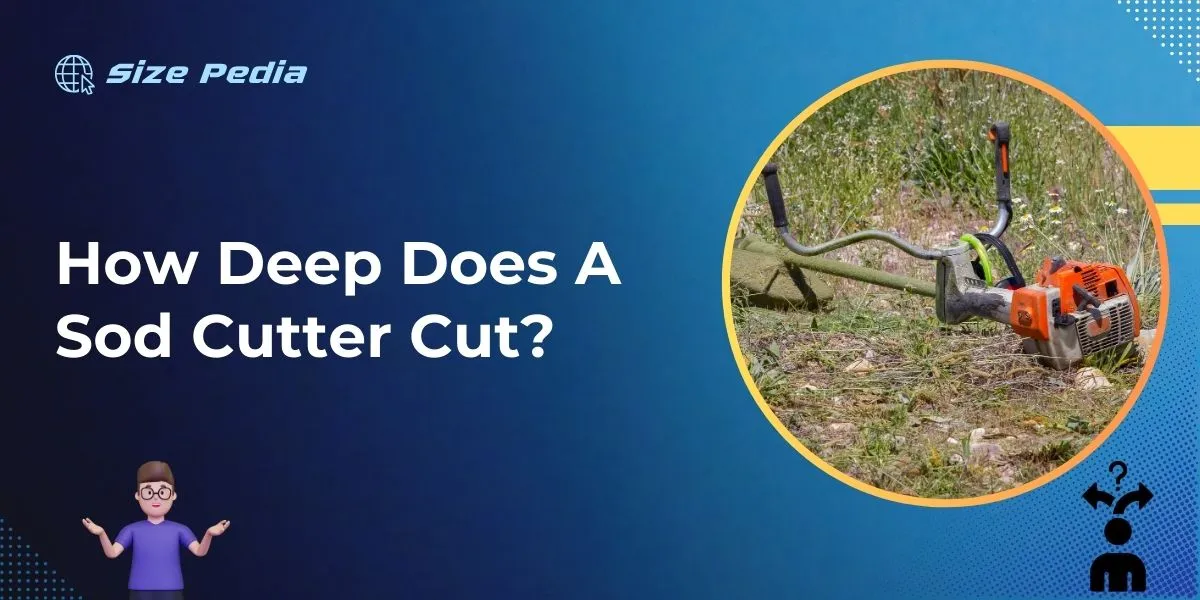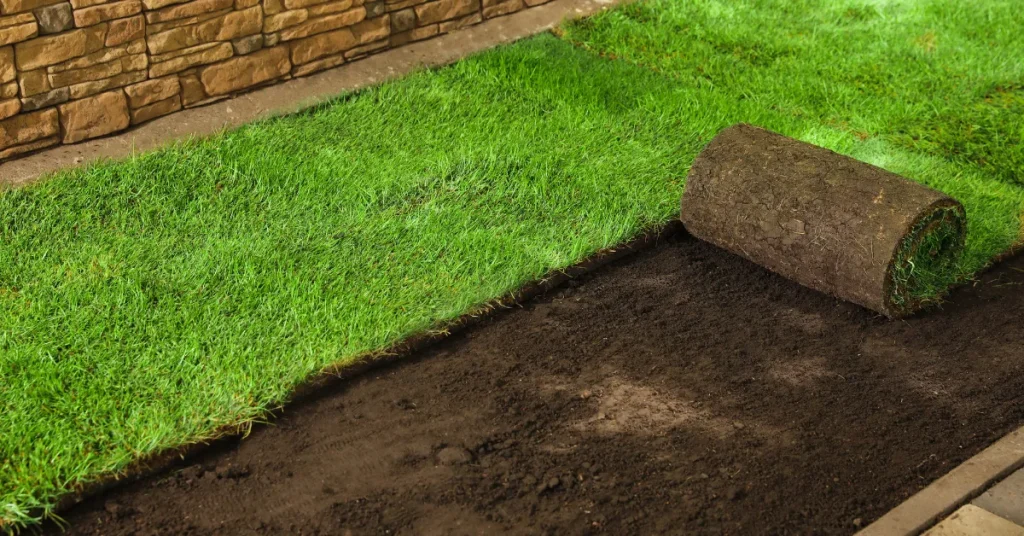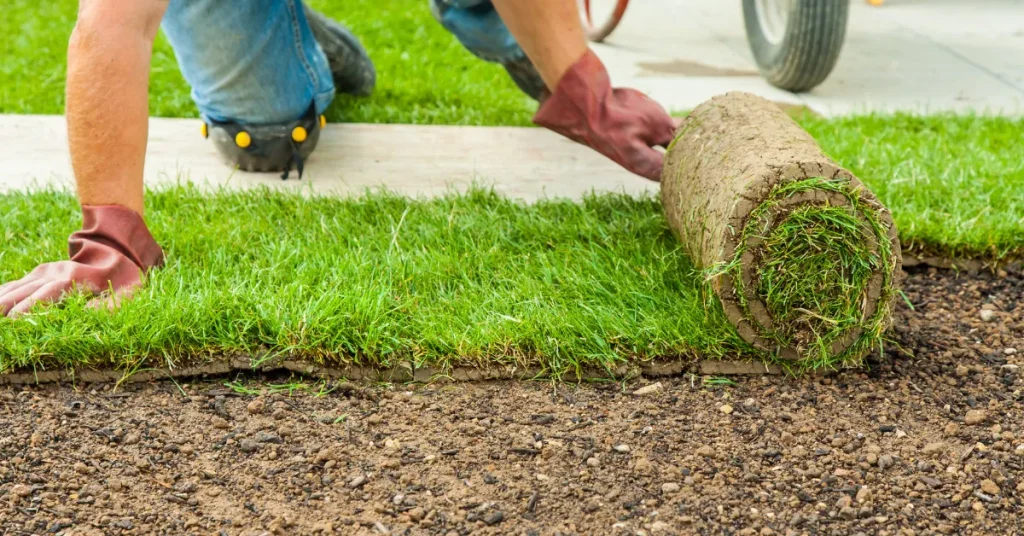A sod cutter typically cuts to a depth of 2 to 2.5 inches. This depth enables the removal of grass and a portion of the root system.
Preparing your landscape for new projects often necessitates the removal of existing grass and sod. A sod cutter excels in this task, cleanly slicing through the turf to facilitate easy removal.
This tool offers a precise cut, ensuring minimal damage to the underlying soil while making the process efficient for both small and large areas.
For gardeners and landscapers looking to lay fresh sod or embark upon projects like gardening beds or patios, a sod cutter is an indispensable piece of equipment.
With its specific cutting depth, it guarantees that only the necessary amount of sod is removed, allowing for a smooth transition to the next phase of landscaping without extensive manual labor or soil disruption.

The Mechanics Of A Sod Cutter
The mechanics of a sod cutter are designed for precision and efficiency. This powerful tool slices into the ground, effectively separating sod from the soil beneath.
It’s tailor-made for gardeners and landscapers looking to redesign their outdoor space. Understanding how this machine operates can unlock new possibilities for lawn renovation.
Types And Models
Diverse types and models of sod cutters cater to various landscaping needs.
- Manual sod cutters: These are simple, push-style tools ideal for small jobs.
- Gas-powered sod cutters: Perfect for large areas with their motor-driven blades.
- Electric sod cutters: Offer a quieter operation suited for residential use.
Each type serves a unique purpose, ensuring the right fit for any project size.
Blade Specifications
Blade specifications determine the cutter’s performance.
| Blade Width | Depth Range |
| 12″ to 18″ | 1″ to 2.5″ |
| 18″ to 24″ | 2″ to 4″ |
Blades are crafted for optimal cutting depth, ensuring a clean cut every time. They can usually be adjusted to accommodate the desired depth, providing versatility in sod removal.
Determining Cutting Depth

Knowing the exact depth a sod cutter will dive becomes crucial for a perfect lawn renovation. A sod cutter slices beneath the grass, extracting both the foliage and the roots. The depth is adjustable to suit various soil types and landscaping needs.
Let’s delve into the factors that decide how deep the blades go, and compare manual and motorized options for depth adjustments.
Factors Influencing Depth
- Soil Type: Compact soil may require a shallower cut than loose soil.
- Grass Species: Deep-rooted varieties need more depth.
- Project Goal: Replanting demands deeper cuts to remove old roots.
Set the optimal depth to protect irrigation lines and utilities underground. Align the depth with the project’s end goal, be it replanting or sod removal.
Manual Vs. Motorized Depth Adjustments
Manual sod cutters often have a preset depth option. Twist a knob or lever to change the setting. It’s simple and requires no power source. They are ideal for smaller projects.
Motorized sod cutters provide precision with variable depth control. Adjustments happen with a switch or dial, specifically catering to different project needs. These are perfect for larger areas.
| Sod Cutter Type | Depth Adjustments | Suitable For |
| Manual | Fixed Settings | Small Areas |
| Motorized | Variable | Large Areas |
Choosing between manual and motorized models hinges on the project’s size, the physical effort one can exert, and the precision required. Both types allow for depth adjustment, though motorized cutters offer more flexibility and ease of use.
Optimal Depths For Various Applications
When it comes to using a sod cutter, knowing the optimal depth for the job ensures success. Different projects require unique depth settings for the best results. Let’s explore how to set the depth perfectly for a variety of tasks.
Laying New Turf
For fresh, level lawns, precision is key. A sod cutter should slice through the soil at about 1 to 1.5 inches deep. This depth removes grass and a bit of soil. It creates a smooth surface for the new sod to root effectively.
Garden Renovation
Revamping your garden might mean cutting deeper. Aim for a depth of 2 inches with the sod cutter. This ensures old roots are cleared away, readying the area for planting.
Utility Trenching
Trenching for utilities demands precision. Cutting anywhere from 4 to 6 inches deep is typical. This depth accommodates most cables and pipelines, ensuring they’re protected and out of sight.
Remember: Always check the blade before starting. An adjusted blade ensures the sod cutter works at the chosen depth.
| Application | Optimal Depth |
| Laying New Turf | 1 – 1.5 inches |
| Garden Renovation | 2 inches |
| Utility Trenching | 4 – 6 inches |
Maximizing Efficiency With Proper Depth Settings
Setting the correct depth on a sod cutter is crucial for both efficient work and resource conservation. Achieving the perfect cut involves understanding the sod’s root system and the soil condition.
Proper depth settings can lead to a smoother process with less waste and effort. Let’s explore how to optimize your sod cutting with precision.
Conserving Effort And Resources
Working smarter, not harder, begins with a sod cutter’s depth calibration.
- Aim for just below the root level. This minimizes soil disturbance and preserves your back.
- Consider soil type—clay calls for more strength, sandy soil less.
- Adjust for moisture; wet soil may need a shallower cut.
Balancing these aspects prevents overuse of energy and safeguards the sod’s integrity.
Avoiding Common Mistakes
Mistakes with sod cutting are often down to depth errors.
| Mistake | Consequence | Prevention |
| Too Deep | Wasted effort and potential damage to cutter blades. | Measure the sod and set cutter depth 1/4 inch deeper. |
| Too Shallow | Incomplete cuts and uneven sod strips. | Check for proper sod cutter basis and adjust. |
Remember, the right depth depends on what you know about the sod, soil, and conditions of the day.
Maintaining And Troubleshooting Your Sod Cutter

A sod cutter is essential for slicing through turf with precision. Maintaining your sod cutter ensures optimal performance. Operators face blade sharpness and mechanism issues. Below are ways to keep your sod cutter in top condition.
Sharpness And Blade Replacement
Blades must stay sharp for clean cuts. Dull blades tear grass and soil. This results in uneven sod strips. Check blades regularly.
- Inspect the blade before each use.
- If the blade is dull, sharpen it using a file or stone.
- Replace blades when sharpening no longer works.
Refer to the user manual for replacement guidelines. Use the correct blade type for your model.
Depth Adjustment Mechanism Issues
A sod cutter’s depth is adjustable. Troubleshoot depth issues promptly.
- Ensure the adjustment lever moves smoothly.
- Oil moving parts if the mechanism sticks.
- Clean out dirt and debris that could block the lever.
- Check for worn parts if the cutter doesn’t maintain depth.
Consult the manual for mechanism repair steps. Seek professional help for complex issues.
FAQs About How Deep Does A Sod Cutter Cut
What Is The Cutting Depth Of A Sod Cutter?
A sod cutter typically cuts between 1 to 2. 5 inches deep. This range allows users to remove grass efficiently without damaging underlying systems.
Can Sod Cutter Depth Be Adjusted?
Yes, most sod cutters come with adjustable blades. You can fine-tune the cutting depth to your specific landscaping needs, ensuring precise control.
Is A Sod Cutter Easy To Operate?
Operating a sod cutter requires some physical strength, but it’s straightforward. With a brief orientation and safety considerations, most people can handle it well.
What Types Of Sod Cutters Are Available?
There are manual and powered sod cutters. Manual ones are suitable for small jobs, while powered cutters are better for larger or more frequent tasks.
Conclusion
As we’ve explored, sod cutters can penetrate the soil to varying depths, typically ranging from 1 to 2. 5 inches. Selecting the proper depth is crucial for your landscaping project to ensure healthy turf removal or garden preparation.
With the right sod cutter depth, your landscaping dreams are within reach, poised for successful implementation and long-lasting beauty.
Remember, the key to a pristine lawn starts beneath the surface!
Resources:
1. https://extension.umn.edu/lawn-care/renovating-lawn-quality-and-sustainability
